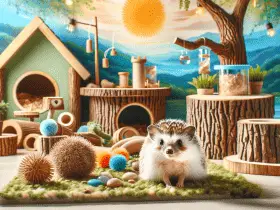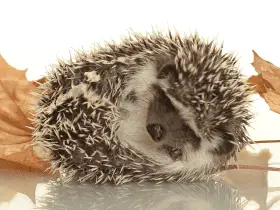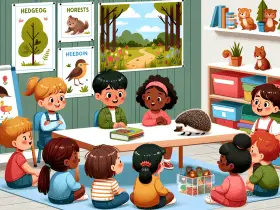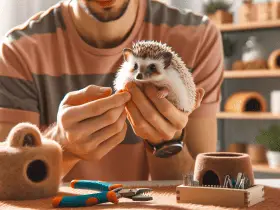As fellow hedgehog enthusiasts, we know how important it is to create a safe haven for our prickly pals. In this article, we’ll dive into the essential steps you need to take to ensure a secure environment for your beloved hedgehog.
From providing the right housing and maintaining optimal temperature and humidity levels, to offering enriching toys and creating a play area free from hazards – we’ve got you covered.
Let’s make sure your hedgehog feels right at home!
Key Takeaways
- Provide appropriate housing with fleece or paper-based bedding and avoid cedar or pine shavings.
- Maintain the temperature range of 72°F to 80°F and humidity level of 40-50% using heating pads or ceramic heat emitters.
- Ensure proper lighting with sunlight or artificial UVB light to mimic natural daylight and enhance mood and behavior.
- Choose safe and enriching toys made from non-toxic materials, provide mental stimulation and exercise opportunities, and regularly inspect and replace worn-out toys.
Hedgehog Housing Requirements
To ensure a safe environment for your hedgehog, you’ll need to meet their specific housing requirements. Hedgehogs require a comfortable and secure space to call home. When it comes to bedding options, there are several choices that can provide the ideal combination of comfort and cleanliness.
One popular option is fleece bedding. Fleece is soft and cozy, making it a great choice for your hedgehog’s sensitive feet. It is also easy to clean as you can simply shake off any loose debris or spot clean with warm water and mild detergent.
Another option is paper-based bedding, which offers good absorbency and odor control. However, be sure to avoid using cedar or pine shavings as they can be harmful to your pet’s respiratory system.
When it comes to cleaning and maintenance, regular upkeep is essential for your hedgehog’s health and well-being. Spot clean the enclosure daily by removing any soiled bedding or waste. Once a week, thoroughly clean the entire habitat using a pet-safe disinfectant. This will help prevent the buildup of bacteria that could lead to illness.
Temperature and Humidity Control
Maintain a consistent temperature and humidity level in their habitat to keep your hedgehog comfortable and healthy.
Hedgehogs are native to regions with moderate climates, so it is crucial to replicate those conditions in their enclosure. The ideal temperature range for hedgehogs is between 72°F (22°C) and 80°F (27°C). To achieve this, use a heating pad or ceramic heat emitter placed on one side of the enclosure. This allows the hedgehog to regulate its body temperature by moving closer or farther away from the heat source as needed.
Humidity control is equally important for hedgehog health. Aim for a humidity level of around 40-50%. Low humidity can cause dry skin and respiratory issues, while high humidity can lead to fungal growth and other health problems. Use a digital hygrometer to monitor the humidity levels regularly.
To maintain proper humidity, you can use a humidifier or mist the enclosure with water daily. Additionally, provide adequate ventilation to prevent excessive moisture buildup.
Remember that hedgehogs are sensitive creatures, so sudden changes in temperature or humidity can be stressful for them. Keep an eye on these factors and make adjustments as necessary to ensure a comfortable environment for your beloved pet.
Proper Lighting for Hedgehog Health
Proper lighting is essential for the overall health and well-being of your hedgehog. Here are three key reasons why you should prioritize lighting in your hedgehog’s habitat:
- Mimics natural daylight: Hedgehogs are naturally diurnal animals, meaning they are most active during the day. Providing them with proper lighting fixtures that simulate natural daylight can help regulate their sleep-wake cycle and promote a sense of belonging.
- Promotes vitamin D synthesis: Like humans, hedgehogs also require exposure to sunlight or artificial UVB light to synthesize vitamin D. This vitamin plays a crucial role in calcium absorption and bone health.
- Enhances mood and behavior: Adequate lighting can have a significant impact on your hedgehog’s mood and behavior. Brighter lights during the day can stimulate activity levels, while dimmer lights at night can create a more calming environment for sleep.
To ensure your hedgehog receives optimal lighting, invest in lighting fixtures specifically designed for reptiles or small mammals. These fixtures often include UVB bulbs that provide the necessary benefits mentioned above. Remember to consult with a veterinarian to determine the appropriate duration and intensity of light exposure for your pet hedgehog.
Safe and Enriching Hedgehog Toys
Make sure you choose toys that are specifically designed for hedgehogs and provide them with mental stimulation and physical exercise. Hedgehogs are curious creatures that need a safe and enriching environment to thrive in.
When it comes to hedgehog toy safety, there are a few important factors to consider. Firstly, always opt for toys that are made from non-toxic materials. Hedgehogs have a tendency to nibble on things, so it’s crucial to ensure that the toys they play with won’t harm them if ingested. Look for toys made from natural materials such as wood or pet-safe plastics.
Secondly, interactive toys are highly beneficial for hedgehogs. These types of toys engage their senses and promote mental stimulation. Puzzle feeders, for example, can keep your hedgehog entertained while also providing them with a challenge as they try to access their food.
Additionally, make sure the toys offer physical exercise opportunities. Hedgehogs need regular exercise to maintain their health and prevent obesity. Toys like tunnels or running wheels can help fulfill this need while keeping them active and entertained.
Remember to regularly inspect your hedgehog’s toys for any signs of wear or damage. Replace worn-out items promptly to avoid any potential hazards.
Essential Diet and Feeding Guidelines
When it comes to providing a healthy diet for our hedgehogs, there are several important factors to consider.
First and foremost, we need to ensure that we are offering suitable food options that meet their nutritional needs.
It is also crucial to follow feeding frequency recommendations in order to maintain a balanced diet and prevent overfeeding.
Lastly, we must be aware of potential dietary hazards that could harm our hedgehogs, such as certain foods that are toxic or difficult for them to digest.
Suitable Food Options
You’ll want to consider the suitable food options for your hedgehog. Providing a well-balanced diet is essential for maintaining hedgehog health and meeting their nutritional needs.
Here are three food options that will keep your hedgehog happy and healthy:
- Insects: Hedgehogs are insectivores, so offering live insects like crickets, mealworms, and waxworms can be a great source of protein.
- High-quality cat food: Look for cat food with high protein content and low fat content. Avoid brands that contain fillers or artificial additives.
- Fruits and vegetables: While it’s important to remember that fruits and vegetables should only make up a small portion of their diet, including small amounts of fruits like apples or berries, as well as veggies like carrots or peas, can provide added nutrients.
Feeding Frequency Recommendations
Now that we have discussed suitable food options for your hedgehog, let’s dive into the feeding frequency recommendations.
Establishing a proper hedgehog feeding schedule is crucial to ensure their health and well-being.
Hedgehogs are small creatures with high metabolic rates, so they require regular meals throughout the day. It is recommended to feed them once in the morning and once in the evening. This will provide them with a steady supply of nutrients and help maintain their energy levels.
When it comes to hedgehog feeding tips, it’s important to offer a balanced diet that includes commercial hedgehog food, insects, and occasional fruits or vegetables as treats. Avoid overfeeding your hedgehog as they can easily become overweight.
Potential Dietary Hazards
Feeding your hedgehog certain foods, such as chocolate or caffeine, can be harmful to their health. It’s important to create a safe environment for our little prickly friends by being mindful of potential dietary hazards.
Here are some hazardous plants and toxic household items that should be kept away from your hedgehog:
- Hazardous Plants: Some common plants like azaleas, lilies, and ivy can be toxic to hedgehogs if ingested. It’s crucial to ensure that these plants are out of reach.
- Toxic Household Items: Hedgehogs have a curious nature and may explore their surroundings. Items like cleaning products, pesticides, and certain medications can be extremely dangerous if consumed by your pet. Make sure these items are securely stored in cabinets or locked away.
Creating a Hedgehog-Friendly Play Area
When it comes to creating a hedgehog-friendly play area, there are two key points to consider: the ideal play area and safety precautions.
The ideal play area should provide enough space for your hedgehog to explore and exercise, with plenty of hiding spots and toys for enrichment.
As for safety precautions, it is important to ensure that the play area is escape-proof, free from any potential hazards or toxic substances, and regularly cleaned to maintain hygiene.
Ideal Play Area
Creating an ideal play area for your hedgehog involves providing a space that is secure and conducive to their natural behaviors. Here are three key elements to consider when setting up the perfect play area:
- Outdoor Play: Giving your hedgehog the opportunity to explore outside can be beneficial for their physical and mental well-being. Ensure that the outdoor space is fully enclosed, free from any potential hazards, and escape-proof.
- Playtime Routine: Establishing a consistent playtime routine is essential for your hedgehog’s happiness and stimulation. Set aside specific times each day for interactive play sessions, using toys and tunnels to encourage exercise and exploration.
- Enrichment Activities: Hedgehogs are curious creatures who thrive on mental stimulation. Incorporate puzzles, hiding spots, and different textures into their play area to keep them engaged and entertained.
Safety Precautions
When it comes to ensuring a safe environment for your hedgehog, safety precautions are of utmost importance. It is essential to have proper safety training and emergency preparedness measures in place.
Firstly, it is crucial to educate yourself on potential hazards and how to prevent them. This includes understanding the risks associated with certain household items, such as toxic plants or chemicals that could harm your hedgehog. Additionally, you should be aware of common health issues that may require immediate attention.
Emergency preparedness also plays a significant role in hedgehog care. Have a designated area for first aid supplies readily available at all times. Familiarize yourself with basic first aid techniques for hedgehogs and know when it is necessary to seek professional veterinary assistance.
Identifying and Preventing Common Hedgehog Hazards
To keep your hedgehog safe, it’s important to identify and prevent common hazards. Here is a hedgehog proofing checklist to help you create a secure environment for your prickly pal:
- Secure electrical cords: Hedgehogs are curious creatures and may chew on electrical cords, which can be dangerous. To prevent this, use cord covers or hide the cords behind furniture.
- Avoid toxic plants: Some common household plants, such as lilies and ivy, can be toxic to hedgehogs if ingested. Make sure to research which plants are safe and remove any potentially harmful ones from your home.
- Beware of small spaces: Hedgehogs love exploring but can easily get stuck in small spaces like vents or under furniture. Block off any areas where they could become trapped to ensure their safety.
By following this hedgehog proofing checklist, you’ll be able to protect your furry friend from common household dangers.
Frequently Asked Questions
Can Hedgehogs Be Kept Outdoors in a Hutch or Cage?
Hedgehogs can be kept outdoors in a hutch or cage, but it’s important to consider the pros and cons. We’ll guide you on how to make it safe while hedgehog proofing your yard with helpful tips and precautions.
How Often Should I Clean My Hedgehog’s Cage?
When it comes to cleaning our hedgehog’s cage, we make sure to do it regularly. This not only ensures a safe environment for our pet but also helps maintain their overall health and well-being.
Are There Any Specific Types of Toys That Hedgehogs Should Avoid?
To ensure our hedgehog’s safety, we should be aware of toys that may pose risks. It is important to avoid toxic materials and potential choking hazards when selecting toys for our beloved spiky companion.
Can Hedgehogs Eat Fruits and Vegetables?
Yes, hedgehogs can eat fruits and vegetables. However, it’s important to maintain a balanced diet for them. Fruits and vegetables provide vitamins and nutrients but can also pose health risks if not given in moderation.
What Are Some Common Household Items That Could Be Hazardous to Hedgehogs?
To keep our hedgehogs safe, we need to be aware of common household hazards. Some items, like toxic plants and cleaning chemicals, can pose a risk. Let’s make sure our hedgehog’s environment is secure and welcoming.
Conclusion
In conclusion, ensuring a safe environment for our beloved hedgehogs is of utmost importance. By following the housing requirements, controlling temperature and humidity, providing proper lighting, and offering safe and enriching toys, we can guarantee their well-being.
Additionally, a balanced diet and feeding guidelines are essential for their health. Creating a hedgehog-friendly play area will keep them happy and active.
Lastly, identifying and preventing common hazards will protect our prickly pals from any potential harm. Let’s create a haven where hedgehogs can thrive!
















Leave a Reply
View Comments